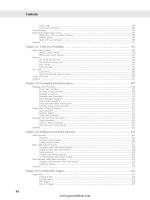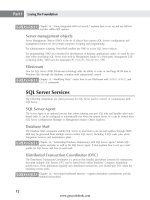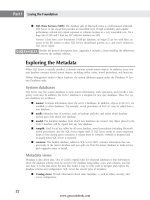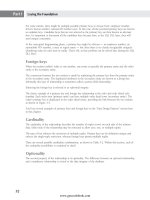Hướng dẫn học Microsoft SQL Server 2008 part 46 ppsx
Bạn đang xem bản rút gọn của tài liệu. Xem và tải ngay bản đầy đủ của tài liệu tại đây (610.29 KB, 10 trang )
Nielsen c17.tex V4 - 07/21/2009 12:57pm Page 412
Part III Beyond Relational
ON C.BusinessEntityID = Emp.BusinessEntityID
LEFT JOIN Person.Person AS M
ON Emp.ManagerID = M.BusinessEntityID
ORDER BY Lv, BusinessEntityID;
Result (abbreviated):
BusinessEntityID ManagerID
Lv Name JobTitle Manager
1 263 Jean Trenary Information Services Manager 1 Ken S
´
anchez
2 264 Stephanie Conroy Network Manager 263 Jean Trenary
2 267 Karen Berg Application Specialist 263 Jean Trenary
2 268 Ramesh Meyyappan Application Specialist 263 Jean Trenary
2 269 Dan Bacon Application Specialist 263 Jean Trenary
2 270 Fran
¸
cois Ajenstat Database Administrator 263 Jean Trenary
2 271 Dan Wilson Database Administrator 263 Jean Trenary
2 272 Janaina Bueno Application Specialist 263 Jean Trenary
3 265 Ashvini Sharma Network Administrator 264 Stephanie Conroy
3 266 Peter Connelly Network Administrator 264 Stephanie Conroy
A nice feature of the table-valued user-defined function is that it can be called from the CROSS APPLY
(new in SQL Server 2005), which executes the function once for every row in the outer query. Here,
the
CROSS APPLY is used with the function to generate an extensive list of every report under every
BusinessEntityID from HumanResources.Employee:
using Cross Apply to report all node under everyone
SELECT E.BusinessEntityID, OT.BusinessEntityID, OT.Lv
FROM HumanResources.Employee AS E
CROSS APPLY dbo.OrgTree(BusinessEntityID) AS OT;
The next query builds on the previous query, adding a GROUP BY to present a count of the number
of reports under every manager. Because it explodes out every manager with its complete subtree, this
query returns not 290 rows, but 1,308:
Count of All Reports
SELECT E.BusinessEntityID, COUNT(OT.BusinessEntityID)-1 AS ReportCount
FROM HumanResources.Employee E
CROSS APPLY dbo.OrgTree(BusinessEntityID) OT
GROUP BY E.BusinessEntityID
HAVING COUNT(OT.BusinessEntityID) > 1
ORDER BY COUNT(OT.BusinessEntityID) DESC;
Result (abbreviated):
BusinessEntityID BusinessEntityID Lv
111
122
1162
1252
1 234 2
412
www.getcoolebook.com
Nielsen c17.tex V4 - 07/21/2009 12:57pm Page 413
Traversing Hierarchies 17
Recursive CTE looking up the hierarchy
The previous adjacency list subtree queries all looked down the hierarchical tree. Searching up the tree
returns the path from the node in question to the top of the hierarchy — for an organizational chart, it
would return the chain of command from the current node to the top of the organizational chart. The
technical term for this search is an ancestor search.
The queries to search up the hierarchy are similar to the downward-looking queries, only the direction
of the join is modified. The following queries demonstrate the modification.
This query returns Franc¸ois the DBA’s chain of command to the CEO using a recursive CTE:
Adjacency list
navigating up the tree
Recursive CTE
WITH OrgPathUp (BusinessEntityID, ManagerID, lv)
AS (
Anchor
SELECT BusinessEntityID, ManagerID, 1
FROM HumanResources.Employee
WHERE BusinessEntityID = 270 Fran
¸
cois Ajenstat the DBA
Recursive Call
UNION ALL
SELECT E.BusinessEntityID, E.ManagerID, lv + 1
FROM HumanResources.Employee AS E
JOIN OrgPathUp
ON OrgPathUp.ManagerID = E.BusinessEntityID
)
SELECT Lv, Emp.BusinessEntityID,
C.FirstName + ‘ ‘ + C.LastName AS [Name],
Emp.JobTitle
FROM HumanResources.Employee Emp
JOIN OrgPathUp
ON Emp.BusinessEntityID = OrgPathUp.BusinessEntityID
JOIN Person.Person AS C
ON C.BusinessEntityID = Emp.BusinessEntityID
LEFT JOIN Person.Person AS M
ON Emp.ManagerID = M.BusinessEntityID
ORDER BY Lv DESC, BusinessEntityID
OPTION (MAXRECURSION 20);
Result:
BusinessEntityID
Lv Name JobTitle
3 1 Ken S
´
anchez Chief Executive Officer
2 263 Jean Trenary Information Services Manager
1 270 Fran
¸
cois Ajenstat Database Administrator
413
www.getcoolebook.com
Nielsen c17.tex V4 - 07/21/2009 12:57pm Page 414
Part III Beyond Relational
Searching up the hierarchy with a user-defined function
Modifying the recursive CTE to search up the hierarchy to find the chain of command, instead of search
down the hierarchy to find the subtree, was as simple as changing the join criteria. The same is true for
a user-defined function. The next function searches up the hierarchy and is called for Franc¸ois the DBA.
The modified join is shown in bold:
Classic UDF
CREATE FUNCTION dbo.OrgTreeUP
(@BusinessEntityID INT)
RETURNS @Tree TABLE (BusinessEntityID INT, ManagerID INT, Lv INT)
AS
BEGIN
DECLARE @LC INT = 1
insert the starting level (anchor node)
INSERT @Tree (BusinessEntityID, ManagerID, Lv)
SELECT BusinessEntityID, ManagerID, @LC
FROM HumanResources.Employee AS E the employee
WHERE BusinessEntityID = @BusinessEntityID
Loop through each lower levels
WHILE @@RowCount > 0
BEGIN
SET @LC = @LC + 1
insert the Next level of employees
INSERT @Tree (BusinessEntityID, ManagerID, Lv)
SELECT NextLevel.BusinessEntityID,
NextLevel.ManagerID, @LC
FROM HumanResources.Employee AS NextLevel
JOIN @Tree AS CurrentLevel
ON NextLevel.BusinessEntityID
= CurrentLevel.ManagerID
WHERE CurrentLevel.Lv = @LC - 1
END
RETURN
END;
go
calling the Function
chain of command up from Fran
¸
cois
SELECT * FROM dbo.OrgTreeUp(270); Fran
¸
cois Ajenstat the DBA
Result :
BusinessEntityID ManagerID Lv
270 263 1
263 1 2
1 NULL 3
414
www.getcoolebook.com
Nielsen c17.tex V4 - 07/21/2009 12:57pm Page 415
Traversing Hierarchies 17
Is the node an ancestor?
A common programming task when working with hierarchies is answering the question, Is node A in
node B subtree? In practical terms, it’s asking, ‘‘Does Franc¸ois, the DBA, report to Jean Trenary, the IT
manager?’’
Using an adjacency list to answer that question from an adjacency list is somewhat complicated, but it
can be done by leveraging the subtree work from the previous section.
Answering the question ‘‘Does employee 270 report to node 263?’’ is the same question as ‘‘Is node 270
an ancestor of node 263?’’ Both questions can be expressed in SQL as, ‘‘Is the ancestor node in current
node’s the ancestor list?’’ The
OrgTreeUp() user-defined function returns all the ancestors of a given
node, so reusing this user-defined function is the simplest solution:
SELECT ‘True’
WHERE 263 263: Jean Trenary
IN (SELECT BusinessEntityID FROM OrgTreeUp(270));
270: Fran
¸
cois Ajenstat the DBA
Result:
True
Determining the node’s level
Because each node only knows about itself, there’s no inherent way to determine the node’s level with-
out scanning up the hierarchy. Determining a node’s level requires either running a recursive CTE or
user-defined function to navigate up the hierarchy and return the column representing the level.
Once the level is returned by the recursive CTE or user-defined function, it’s easy to update a column
with the
lv value.
Reparenting the adjacency list
As with any data, there are three types of modifications: inserts, updates, and deletes. With a hierarchy,
inserting at the bottom of the node is trivial, but inserting into the middle of the hierarchy, updating a
node to a different location in the hierarchy, or deleting a node in the middle of the hierarchy can be
rather complex.
The term used to describe this issue is reparenting — assigning a new parent to a node or set of nodes.
For example, in
AdventureWorks2008, IT Manager Jean Trenary reports directly to CEO Ken
S
´
anchez, but what if a reorganization positions the IT dept under Terri Duffy, VP of Engineering? How
many of the nodes would need to be modified, and how would they be updated? That’s the question of
reparenting the hierarchy.
Because each node only knows about itself and its direct parent node, reparenting an adjacency list is
trivial. To move the IT dept under the VP of Engineering, simply update Jean Trenary’s
ManagerID
value:
UPDATE HumanResources.Employee
SET ManagerID = 2 Terri Duffy, Vice President of Engineering
WHERE BusinessEntityID = 263; Jean Trenary IT Manager
415
www.getcoolebook.com
Nielsen c17.tex V4 - 07/21/2009 12:57pm Page 416
Part III Beyond Relational
Deleting a node in the middle of the hierarchy is potentially more complex but is limited to modify-
ing n nodes, where n is the number of nodes that have the node being deleted as a parent. Each node
under the node to be deleted must be reassigned to another node. By default, that’s probably the deleted
node’s
ManagerID.
Indexing an adjacency list
Indexing an adjacency list pattern hierarchy is rather straightforward. Create a non-clustered index on
the column holding the parent node ID. The current node ID column is probably the primary key and
the clustered index and so will be automatically included in the non-clustered index. The parent ID
index will gather all the subtree values by parent ID and perform fast index seeks.
The following code was used to index the parent ID column when the adjacency list pattern was
restored to
AdventureWorks2008 at the beginning of this chapter:
CREATE INDEX IxParentID
ON HumanResources.Employee
(ManagerID);
If the table is very wide (over 25 columns) and large (millions of rows) then a non-clustered index on
the primary key and the parent ID will provide a narrow covering index for navigation up the hierachy.
Cyclic errors
As mentioned earlier, every node in the adjacency list pattern knows only about itself and its parent
node. Therefore, there’s no SQL constraint than can possibly test for or prevent a cyclic error.
If someone plays an April Fools Day joke on Jean Trenary and sets her
ManagerID to, say, 270, so she
reports to the DBA (gee, who might have permission to do that?), it would introduce a cyclic error into
the hierarchy:
UPDATE HumanResources.Employee
SET ManagerID = 270 Fran
¸
cois Ajenstat the DBA
WHERE BusinessEntityID = 263 Jean Trenary IT Manager
The cyclic error will cause the OrgTree function to loop from Jean to Franc¸ois to Jean to Franc¸ois for-
ever, or until the query is stopped. Go ahead and try it:
SELECT ‘True’
WHERE 270 Fran
¸
cois Ajenstat the DBA
IN (SELECT BusinessEntityID FROM OrgTree(263));
Now set it back to avoid errors in the next section:
UPDATE HumanResources.Employee
SET ManagerID = 1 – the CEO
WHERE BusinessEntityID = 263 Jean Trenary IT Manager
To locate cyclic errors in the hierarchy, a stored procedure or function must navigate both up and down
the subtrees of the node in question and use code to detect and report an out-of-place duplication.
Download the latest code to check for cyclic errors from
www.sqlserverbible.com.
416
www.getcoolebook.com
Nielsen c17.tex V4 - 07/21/2009 12:57pm Page 417
Traversing Hierarchies 17
Adjacency list variations
The basic adjacency list pattern is useful for situations that include only a one-parent-to-multiple-nodes
relationship. With a little modification, an adjacency list can also handle more, but it’s not sufficient for
most serious production database hierarchies. Fortunately, the basic data-pair pattern is easily modified
to handle more complex hierarchies such as bills of materials, genealogies, and complex organizational
charts.
Bills of materials/multiple cardinalities
When there’s a many-to-many relationship between current nodes and parent nodes, an associative table
is required, similar to how an associative table is used in any other many-to-many cardinality model. For
example, an order may include multiple products, and each product may be on multiple orders, so the
order detail table serves as an associative table between the order and the product.
The same type of many-to-many problem commonly exists in manufacturing when designing schemas
for bills of materials. For example, part a23 may be used in the manufacturing of multiple other parts,
and part a23 itself might have been manufactured from still other parts. In this way, any part may be
both a child and parent of multiple other parts.
To build a many-to-many hierarchical bill of materials, the bill of materials serves as the adjacency table
between the current part(s) and the parent parts(s), both of which are stored in the same
Parts table,
as shown in Figure 17-5.
The same pattern used to navigate a hierarchy works for a bill of materials system as well — it just
requires working through the
BillOfMaterials table.
The following query is similar to the previous subtree recursive CTE. If finds all the parts used to create
a given assembly — in manufacturing this is commonly called a parts explosion report. In this instance,
the query does a parts explosion for Product 777 — Adventure Works’ popular Mountain-100 bike in
Black with a 44’’ frame:
WITH PartsExplosion (ProductAssemblyID, ComponentID, lv, Qty)
AS (
Anchor
SELECT ProductID, ProductID, 1, CAST(0 AS DECIMAL (8,2))
FROM Production.Product
WHERE ProductID = 777 Mountain-100 Black, 44
Recursive Call
UNION ALL
SELECT BOM.ProductAssemblyID, BOM.ComponentID, lv + 1, PerAssemblyQty
FROM PartsExplosion CTE
JOIN (SELECT *
FROM Production.BillOfMaterials
WHERE EndDate IS NULL
)ASBOM
ON CTE.ComponentID = BOM.ProductAssemblyID
)
SELECT lv, PA.NAME AS ‘Assembly’, PC.NAME AS ‘Component’,
417
www.getcoolebook.com
Nielsen c17.tex V4 - 07/21/2009 12:57pm Page 418
Part III Beyond Relational
CAST(Qty AS INT) as Qty
FROM PartsExplosion AS PE
JOIN Production.Product AS PA
ON PE.ProductAssemblyID = PA.ProductID
JOIN Production.Product AS PC
ON PE.ComponentID = PC.ProductID
ORDER BY Lv, ComponentID ;
FIGURE 17-5
The bill of materials structure in AdventureWorks uses an adjacency table to store which parts
(ComponentID) are used to manufacture which other parts (ProductAssembyID).
The result is a complete list of all the parts required to make a mountain bike:
lv Assembly Component Qty
1 Mountain-100 Black, 44 Mountain-100 Black, 44 0
2 Mountain-100 Black, 44 HL Mountain Seat Assembly 1
2 Mountain-100 Black, 44 HL Mountain Frame - Black,44 1
418
www.getcoolebook.com
Nielsen c17.tex V4 - 07/21/2009 12:57pm Page 419
Traversing Hierarchies 17
2 Mountain-100 Black, 44 HL Headset 1
2 Mountain-100 Black, 44 HL Mountain Handlebars 1
2 Mountain-100 Black, 44 HL Mountain Front Wheel 1
2 Mountain-100 Black, 44 HL Mountain Rear Wheel 1
4 Chain Stays Metal Sheet 5 1
4 Handlebar Tube Metal Sheet 6 1
4 BB Ball Bearing Cup-Shaped Race 2
4 BB Ball Bearing Cone-Shaped Race 2
4 HL Hub HL Spindle/Axle 1
4 HL Hub HL Spindle/Axle 1
4 HL Hub HL Shell 1
4 HL Hub HL Shell 1
4 HL Fork Steerer 1
5 Fork End Metal Sheet 2 1
5 Blade Metal Sheet 5 1
5 Fork Crown Metal Sheet 5 1
5 Steerer Metal Sheet 6 1
Adjacency list pros and cons
The adjacency list pattern is common and well understood, with several points in its favor:
■ Reparenting is trivial.
■ It’s easy to manually decode and understand.
On the con side, the adjacency list pattern has these concerns:
■ Consistency requires additional care and manual checking for cyclic errors.
■ Performance is reasonable, but not as fast as the materialized list or
hierarchyID when
retrieving a subtree. The adjacency list pattern is hindered by the need to build the hierarchy
if you need to navigate or query related nodes in a hierarchy. This needs to be done iteratively
using either a loop in a user-defined function or a recursive CTE. Returning data though a
user-defined function also presents some overhead.
The Materialized-Path Pattern
The materialized-path pattern is another excellent method to store and navigate hierarchical data. Basi-
cally, it stores a denormalized, comma-delimited representation of the list of the current node’s complete
ancestry, including every generation of parents from the top of the hierarchy down to the current node.
A common materialized path is a file path:
c:\Users\Pn\Documents\SQLServer2009Bible\AuthorReview\Submitted
Franc¸ois Ajenstat, the DBA, has a hierarchy chain of command that flows from Ken S
´
anchez (ID: 1) the
CEO, to Jean Trenary (ID: 263) the IT Manager, and then down to Franc¸ois (ID: 270). Therefore, his
materialized path would be as follows:
1, 263, 270
419
www.getcoolebook.com
Nielsen c17.tex V4 - 07/21/2009 12:57pm Page 420
Part III Beyond Relational
The following scalar user-defined function generates the materialized path programmatically:
CREATE FUNCTION dbo.MaterializedPath
(@BusinessEntityID INT)
RETURNS VARCHAR(200)
AS
BEGIN
DECLARE @Path VARCHAR(200)
SELECT @Path = ‘’
Loop through Hierarchy
WHILE @@RowCount > 0
BEGIN
SELECT @Path
= ISNULL(RTRIM(
CAST(@BusinessEntityID AS VARCHAR(10)))+ ‘,’,’’)
+ @Path
SELECT @BusinessEntityID = ManagerID
FROM Humanresources.Employee
WHERE BusinessEntityID = @BusinessEntityID
END
RETURN @Path
END;
Executing the function for Franc¸ois Ajenstat (ID:270) returns his materialized path:
Select dbo.MaterializedPath(270) as MaterializedPath
Result:
MaterializedPath
1,263,270,
Because the materialized path is stored as a string, it may be indexed, searched, and manipulated as a
string, which has its pros and cons. These are discussed later in the chapter.
Modifying AdventureWorks2008 for Materialized Path
T
he following script modifies AdventureWorks2008 and builds a materialized path using the previously
added ManagerID data and the newly created MaterializedPath user-defined function:
ALTER TABLE HumanResources.Employee
ADD MaterializedPath VARCHAR(200);
continued
420
www.getcoolebook.com
Nielsen c17.tex V4 - 07/21/2009 12:57pm Page 421
Traversing Hierarchies 17
continued
Go
UPDATE HumanResources.Employee
SET MaterializedPath = dbo.MaterializedPath(BusinessEntityID);
CREATE INDEX IxMaterializedPath
ON HumanResources.Employee
(MaterializedPath);
SELECT BusinessEntityID, ManagerID, MaterializedPath
FROM HumanResources.Employee;
Result (abbreviated):
BusinessEntityID ManagerID MaterializedPath
1 NULL 1,
2 1 1,2,
3 2 1,2,3,
4 3 1,2,3,4,
5 3 1,2,3,5,
6 3 1,2,3,6,
7 3 1,2,3,7,
8 7 1,2,3,7,8,
9 7 1,2,3,7,9,
263 1 1,263,
264 263 1,263,264,
265 264 1,263,264,265,
266 264 1,263,264,266,
267 263 1,263,267,
268 263 1,263,268,
269 263 1,263,269,
270 263 1,263,270,
The way the tasks build on each other for a materialized path are very different from the flow of tasks
for an adjacency list; therefore, this section first explains subtree queries. The flow continues with ances-
tor checks and determining the level, which is required for single-level queries.
Enforcing the structure of the hierarchy — ensuring that every node actually has a
parent — is a bit oblique when using the materialized-path method. However, one
chap, Simon Sabin (SQL Server MVP in the U.K., all-around good guy, and technical editor for this
chapter) has an ingenious method. Instead of explaining it here, I’ll direct you to his excellent website:
/>relationship-with-Path-Hierarchy-model.aspx
421
www.getcoolebook.com









